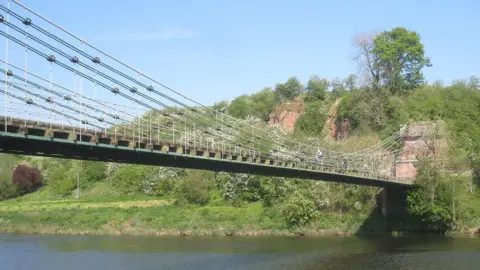Union Chain Bridge recognised as international landmark
 Jonathan Thacker
Jonathan ThackerA 202-year-old bridge that links England and Scotland has been recognised for its historical significance.
The Union Chain Bridge, which crosses the River Tweed, has been named as an International Historic Civil Engineering Landmark.
It joins the likes of the Eiffel Tower, the Sydney Harbour Bridge and the Brooklyn Bridge.
It comes after a complex restoration was completed earlier this year.
The £10.5m overhaul saw every piece of the structure removed, checked and then restored and replaced before being reassembled.
Engineers from across the world bestowed the honour on the bridge, which crosses the river from Horncliffe in Northumberland to Fishwick in the Scottish Borders.
The bridge joins a list of almost 300 structures named.
 LDRS
LDRSSpeaking at the unveiling of the new plaque, Northumberland County Council leader Glen Sanderson said he was "delighted" at the honour.
County councillor Colin Hardy, who represents the Norham and Islandshires ward, said the bridge's restoration would be "a huge boost to tourism".
"We have restored an iconic national monument.
"It is a gateway again between England and Scotland and between communities".
The Union Chain Bridge was built by retired naval captain Samuel Brown and completed in 1820.
It cost about £7,700 to build and replaced a "perilous ford" slightly downstream.
Although work on Thomas Telford's Menai Bridge had started earlier, the Union Bridge was completed first - making it the longest iron suspension bridge in the world when it opened.
Hundreds of spectators, including civil engineers Robert Stevenson and John Rennie, turned out to see it open on 26 July.
Until the 1970s it existed with little maintenance, but the entire deck was replaced in 1974.
The bridge did not receive any major attention until structural issues started to emerge in recent years, leading to the £10.5m overhaul.

Follow BBC North East & Cumbria on Twitter, Facebook and Instagram. Send your story ideas to [email protected].
